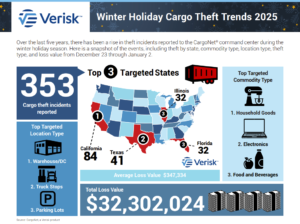FORDYCE, Ark. — At a small truck stop in rural southern Arkansas, driver Sara Hanson is filling up her Peterbilt before heading on to St. Louis.
On this day, she’s got a reefer full of lettuce to deliver by the end of the day. Life on the road is never easy for a truck driver. Hanson said she misses her husband and grandkids, but the money she takes in from hauling helps keep her small family afloat.
One of the worst things Hanson said she has to deal along her many journeys is harassment.
Hanson said she has dealt with her share of bullies in the 20 years she has been behind the wheel of a big rig.
“Bitch, whore, slut — I’ve been called them all, said Hanson, who stands little more than 5 feet tall and has dark gray hair. “I’m 60, and I have seen and heard everything out here on these roads.”
Harassment against truck drivers is prevalent, according to the Federal Motor Carrier Safety Administration’s (FMCSA) new Crime Prevention for Truckers study.
Being called undesirable names (59% of women, 52% of minority males and 51% of non-minority males) and receiving threatening words (38% of women, 40% of minority males and 44% of non-minority males) are the most common forms of harassment, the study noted.
Relative to men (8% of minority and 14% non-minority), women truck drivers (33%) are exposed to more sexual harassment.
Where, when do incidents occur?
Harassment is more likely to happen at truck stops (23 to 30% depending on gender and minority status), places where truck drivers pick up or deliver cargo (15 to 17%) and fueling stations (9 to 11%), according to the study.
In addition, the respondents mentioned that crimes are more likely to happen in urban areas (42 to 56%) compared to rural areas (26 to 35%).
Harassment against women truck drivers is particularly more likely to happen at night (from 12 a.m. to 6 a.m.).
Hanson said that she had a “run-in” with a man she called a “bully driver” last year at a major chain truck stop near Dallas.
“He wanted me to service him, and I said no — hell no, in fact,” Hanson recalled. “But he kept insisting, so I had to tell him I was going to call the police before he stopped. I didn’t feel safe the rest of that night, but I had to stay at the truck stop because my hours were up for the day.”
Characteristics of aggressors
The individuals committing the harassment are more likely to be other truck drivers whom the victims did not already know (e.g., 31% of women, 27% of minority male and 34% of non-minority male truckers who were victims mentioned that the perpetrator was another truck driver whom they did not know before).
Relative to males, women truck drivers are more likely to experience harassment from another truck driver at their company (15%) or their trainers (11%), the study noted.
How many incidents go unreported?
About half of the harassment incidents go unreported (i.e., 42% of women, 57% of minority men and 51% of non-minority men choose not to report the harassment). The reason given was that they did not think that it would make a difference (29 to 38%), or they have to deal with it anyway (17 to 38%).
Statistical analysis comparing crimes among trucker groups
Statistical analysis of the survey data did not find a statistically significant difference in the experience of harassment overall between women and minority men compared to non-minority men. This combined measure refers to at least one incident of occurrence in any of the six specific harassment categories over the preceding two years.
However, statistically significant differences did arise in two harassment categories.
Women truck drivers were found to be two to four times more likely to report being touched without permission compared to non-minority men. Minority women were up to nine times more likely to report being physically harmed compared to non-minority men. Similarly, non-minority women are two to six times as likely than non-minority men to be touched without permission.
SURVEY PARTICIPANTS’ SUGGESTIONS, OBSERVATIONS
Enhance safety at existing trucking facilities
Providing adequate lighting and security features to existing truck parking lots, fueling stations, truck stops and docking areas of shippers and receivers should be the priority. Restrooms should be located closer to parking entrances. Presence of safety patrol and law enforcement is beneficial for safety.
Provide additional parking facilities
The majority of survey participants suggested that many of the crimes that happen against truckers are the direct result of limited parking availability, especially in urban areas. In some cases, truck drivers resorted to parking their trucks on freeway ramps and abandoned lots, putting them at increased risk of accidents and crimes.
Allow firearm carrying in trucking industry
Many respondents mentioned that they would feel safer if they were allowed to carry a firearm.
However, policies of many trucking companies, shippers and receivers do not allow truckers to carry firearms in their trucks. Also, state laws on carrying firearms significantly vary. Many truckers suggested a regulation prohibiting carriers, receivers and shippers from barring truckers to carry legally owned firearms.
Hanson said she has often wanted to skirt the laws and carry a gun in her rig.
“They don’t want us to have protection out here,” Hanson said. “It’s ridiculous. We need something in these cabs to help keep us safe.”
Improve communication within trucking industry
Truck drivers, dispatchers, carriers and customers need to communicate to choose a travel plan that is efficient and safe, e.g., delays and scheduling conflicts at shipper and receiver facilities force truckers to park in unsafe locations.
Provide personal safety training to truck drivers
Many respondents indicated that they never received any type of training on personal safety and protection. Therefore, truck drivers could benefit from personal safety, security and protection training, as well as self-defense programs.
Develop educational material to increase awareness
Educational material that promotes the safety of truck drivers is needed. The material should address topics such as how to recognize, prevent, interject and report crimes. The educational material can also be directed to trucking companies, encouraging them to have a clear and zero-tolerance policy against harassment.
METHODOLOGY
Data collection was planned to be capped at a maximum of 440 each of women, minority men and non-minority men (total of 1,320 responses).
However, there was reluctance from truck drivers to respond to the online survey.
By the time the survey closed, there were a total of 653 qualified respondents to the online survey (201 women, 167 minority male and 285 non-minority male truck drivers).
The actual number of respondents was lower than what was initially anticipated, affecting the sample size and statistical confidence of the results, according to the FMCSA.
The survey was entirely anonymous. None of the questions that were asked could personally identify the respondent or any other individuals involved. Survey instructions reminded the respondent not to include names or other identifying information.
The project team partnered with trucking organizations, trucking consultants and carriers to recruit truck drivers to respond to the online survey. The team prepared an invitation message and materials (posters and flyers) for distribution to the truck drivers who are members of the trucking organizations, trucking consultants and carriers. Promotion of the survey was done primarily through an email invitation sent to the survey partners.
Recruiting materials, i.e., posters and flyers, were also placed at truck stops. The survey was advertised on social media platforms (e.g., postings on Facebook groups of truck drivers, LinkedIn posts and newsletters) of the partnering trucking organizations, trucking consultants and carriers.
The recruiting materials and messages clearly identified the target population and mentioned that the survey was about harassment and assaults against truck drivers.
In total, there are more than 20,000 truck drivers who are members of the partnering trucking organizations, trucking consultants and carriers. These truck drivers live and work in geographically diverse locations around the United States.
Data collection started on January 12, 2022. It continued through February 22, 2022. After the initial invitations were sent to potential respondents via email, follow-up emails were sent twice a week to remind drivers about the survey and encourage them to participate.
Participation was voluntary and respondents were not offered monetary gifts, or any other gifts, for participating.
Click here to access the full study.
The Trucker News Staff produces engaging content for not only TheTrucker.com, but also The Trucker Newspaper, which has been serving the trucking industry for more than 30 years. With a focus on drivers, the Trucker News Staff aims to provide relevant, objective content pertaining to the trucking segment of the transportation industry. The Trucker News Staff is based in Little Rock, Arkansas.
















People are such pigs! This reminds me of the hogs that killed the farmer. Few people talked to the farmer often. No one lived close to him. He had no phone because this was back before most farms had phones.
Anyhow, one day the pigs killed and ate the farmer.
The pigs were in their pen. Later when someone stopped to see the farmer they found the pigs which had starved in their pen. They also found the farmer’s one-of-a-kind belt buckle. That’s how they figured out what happened to him.
It sucks, can’t read it because it moves forward and can’t keep up what paragraph what I’m reading. Keep it simple stupid! Kiss.
The most filthy disrespectful know it all in trucking is the white men….All day every day across every state, They’re complaining,bitching and crying about something!!!!